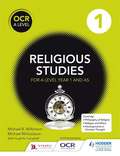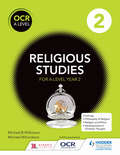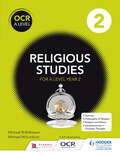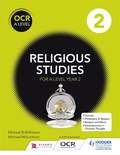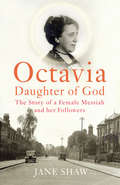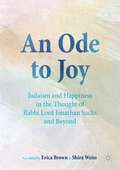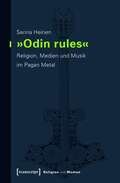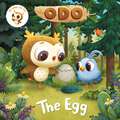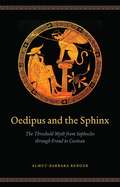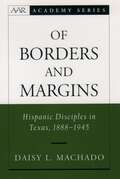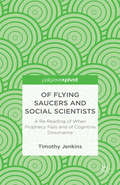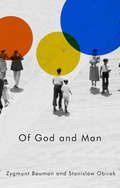- Table View
- List View
OCR Religious Studies A Level Year 1 And AS (PDF)
by Hugh Campbell Michael Wilkinson Michael WilcocksonHelp students to build their subject knowledge and understanding with guidance and assessment preparation from a team of subject specialists; brought to you by the leading Religious Studies publisher and OCR's Publishing Partner. - Develops students' understanding of 'Philosophy of religion' and 'Religion and ethics' through accessible explanations of key theories and terms - Enables you to teach 'Developments in Christian thought' confidently with comprehensive coverage of the key theological arguments - Supports assessment preparation with sample questions and revision advice written by subject specialists - Encourages students to reflect on their learning and develop their own ideas - Helps to extend learning and enhance responses with suggested ideas and additional reading Content covered: - Philosophy of religion - Religion and ethics - Developments in Christian thought
OCR Religious Studies A Level Year 2
by Hugh Campbell Michael Wilkinson Michael WilcocksonHelp students to build their subject knowledge and understanding with guidance and assessment preparation from a team of subject specialists; brought to you by the leading Religious Studies publisher and OCR's Publishing Partner.- Develops students' understanding of 'Philosophy of religion' and 'Religion and ethics' through accessible explanations of key theories and terms- Enables you to teach 'Developments in Christian thought' confidently with comprehensive coverage of the key theological arguments- Supports assessment preparation with sample questions and revision advice written by subject specialists- Encourages students to reflect on their learning and develop their own ideas- Helps to extend learning and enhance responses with suggested ideas and additional readingContent covered:- Philosophy of religion- Religion and ethics- Developments in Christian thought
OCR Religious Studies A Level Year 2
by Michael Wilkinson Michael WilcocksonExam Board: OCRLevel: A-levelSubject: Religious StudiesFirst Teaching: September 2016First Exam: June 2018An OCR endorsed textbookHelp students to build their subject knowledge and understanding with guidance and assessment preparation from a team of subject specialists; brought to you by the leading Religious Studies publisher and OCR's Publishing Partner.- Develops students' understanding of 'Philosophy of religion' and 'Religion and ethics' through accessible explanations of key theories and terms- Enables you to teach 'Developments in Christian thought' confidently with comprehensive coverage of the key theological arguments- Supports assessment preparation with sample questions and revision advice written by subject specialists- Encourages students to reflect on their learning and develop their own ideas- Helps to extend learning and enhance responses with suggested ideas and additional readingContent covered:- Philosophy of religion- Religion and ethics- Developments in Christian thought
OCR Religious Studies A Level Year 2 (PDF)
by Michael Wilkinson Michael WilcocksonExam Board: OCR Level: A-level. Subject: Religious Studies. First Teaching: September 2016. First Exam: June 2018 An OCR endorsed textbook. Help students to build their subject knowledge and understanding with guidance and assessment preparation from a team of subject specialists; brought to you by the leading Religious Studies publisher and OCR's Publishing Partner. Develops students' understanding of 'Philosophy of religion' and 'Religion and ethics' through accessible explanations of key theories and terms. Enables you to teach 'Developments in Christian thought' confidently with comprehensive coverage of the key theological arguments. Supports assessment preparation with sample questions and revision advice written by subject specialists.
Octavia, Daughter of God: The Story Of A Female Messiah And Her Followers
by Jane ShawIn 1919, in the wake of the upheaval of World War I, a remarkable group of English women came up with their own solution to the world's grief:a new religion. At the heart of the Panacea Society was a charismatic and autocratic leader, a vicar's widow named Mabel Barltrop. Her followers called her Octavia, and believed that she was the daughter of God, sent to build the New Jerusalem in Bedford. Proclaiming the female aspects of God, Octavia attracted former suffragettes, middle-class Christian women and passionate spiritual seekers to Bedford, where they followed her in rigorous religious practices. She appointed twelve women as her apostles, and put the rest to work to spread her Word: that human beings, through Panacea, could achieve immortal life on earth.Acclaimed historian Jane Shaw found the last living members of the Panacea Society, who revealed to her their immense, painstakingly-preserved archives. She discovered a utopian community that once had seventy residents, thousands of followers, and an international healing ministry that reached 130,000 people around the globe.Octavia, Daughter of God is a fascinating group biography and a revelatory work of cultural and narrative history. Vividly told, by turns funny and tragic, it reveals in intimate detail the complex, out-sized personality of Octavia; the faith of her devoted followers, who believed they would never die; and the intricacies and intrigues of her close-knit community.But Octavia, Daughter of God is also about a moment at the advent of modernity, when a generation of newly empowered women tried to re-make Christianity in their own image. Startlingly modern in their resolve and curiously reactionary in their social views and politics, their story is a portrait of an age. It offers a window into the anxieties and hopes of the interwar years through the lives of ordinary people who believed extraordinary things about God, this world and the next.
An Ode to Joy: Judaism and Happiness in the Thought of Rabbi Lord Jonathan Sacks and Beyond
by Erica Brown Shira WeissBefore his rather sudden passing in 2020, Rabbi Lord Jonathan Sacks was one of the most eloquent and influential religious leaders of the generation. As Chief Rabbi of the United Hebrew Congregations of the Commonwealth for over two decades, he offered a universal message cultivated from the Jewish and Western cannons he knew so well. One concept that figured prominently in his work was joy. “I think of Judaism as an ode to joy,” he once wrote. “Like Beethoven, Jews have known suffering, isolation, hardship, and rejection, yet they never lacked the religious courage to rejoice.” In this volume, organized by the Rabbi Lord Jonathan Sacks-Herenstein Center for Values and Leadership, academics and writers explore the significance of joy within the Jewish tradition. These essays and reflections discuss traditional Jewish primary sources, including Biblical, Rabbinic and Hebrew literature, Jewish history and philosophy, education, the arts, and positive psychology, and of course, through the prism of Lord Sacks’ work.
»Odin rules«: Religion, Medien und Musik im Pagan Metal (Religion und Medien #3)
by Serina HeinenReligion findet sich nicht nur in Kirchen und Moscheen, sondern auch an profanen Orten wie Heavy Metal-Konzerten. Mittels der Analyse von Konzerten, Liedtexten, CD-Covern und Interviews mit bekannten Musikern im Bereich des Pagan Metal diskutiert Serina Heinen das Verhältnis von Religion und Populärkultur. Dabei tritt ein wichtiger Aspekt von moderner Religion zutage, der in religionssoziologischen Debatten kaum Beachtung findet: Religion im populärkulturellen Kontext ist vieldeutig. Pagan Metal ist voller explizit religionsbezogener Symbolik, doch verstehen die Musiker ihre künstlerische Auseinandersetzung mit Religion nicht zwingend als religiöses Bekenntnis.
Odo: The Egg (Odo)
by OdoMeet Odo and all his friends at Forest Camp in this exciting picture book adventure, based on the animated TV series, now showing on Milkshake!Odo loves going to Forest Camp to play with all his friends, and today Camp Leader has brought some rock eggs for them to look after. Odo tries really hard to be careful with his egg, but when he gets a little over-excited and kicks it into the bushes, he accidentally picks up a real egg instead – and now the egg is hatching!Based on the preschool animated series shown on Milkshake, Odo: The Egg is a charming picture book which captures all the warmth and humour of the TV episodes, with themes of building self-confidence and empathy in a unique beautifully-crafted forest setting. It includes a special spread at the back with reading tips for grown-ups and ideas for discussion with your child.Join Odo and his friends for more adventures at Forest Camp in Super Owl!, Show and Tell and Odo's Sleepover.
Oedipus and the Sphinx: The Threshold Myth from Sophocles through Freud to Cocteau
by Almut-Barbara RengerWhen Oedipus met the Sphinx on the road to Thebes, he did more than answer a riddle—he spawned a myth that, told and retold, would become one of Western culture’s central narratives about self-understanding. Identifying the story as a threshold myth—in which the hero crosses over into an unknown and dangerous realm where rules and limits are not known—Oedipus and the Sphinx offers a fresh account of this mythic encounter and how it deals with the concepts of liminality and otherness. Almut-Barbara Renger assesses the story’s meanings and functions in classical antiquity—from its presence in ancient vase painting to its absence in Sophocles’s tragedy—before arriving at two of its major reworkings in European modernity: the psychoanalytic theory of Sigmund Freud and the poetics of Jean Cocteau. Through her readings, she highlights the ambiguous status of the Sphinx and reveals Oedipus himself to be a liminal creature, providing key insights into Sophocles’s portrayal and establishing a theoretical framework that organizes evaluations of the myth’s reception in the twentieth century. Revealing the narrative of Oedipus and the Sphinx to be the very paradigm of a key transition experienced by all of humankind, Renger situates myth between the competing claims of science and art in an engagement that has important implications for current debates in literary studies, psychoanalytic theory, cultural history, and aesthetics.
Oedipus and the Sphinx: The Threshold Myth from Sophocles through Freud to Cocteau
by Almut-Barbara RengerWhen Oedipus met the Sphinx on the road to Thebes, he did more than answer a riddle—he spawned a myth that, told and retold, would become one of Western culture’s central narratives about self-understanding. Identifying the story as a threshold myth—in which the hero crosses over into an unknown and dangerous realm where rules and limits are not known—Oedipus and the Sphinx offers a fresh account of this mythic encounter and how it deals with the concepts of liminality and otherness. Almut-Barbara Renger assesses the story’s meanings and functions in classical antiquity—from its presence in ancient vase painting to its absence in Sophocles’s tragedy—before arriving at two of its major reworkings in European modernity: the psychoanalytic theory of Sigmund Freud and the poetics of Jean Cocteau. Through her readings, she highlights the ambiguous status of the Sphinx and reveals Oedipus himself to be a liminal creature, providing key insights into Sophocles’s portrayal and establishing a theoretical framework that organizes evaluations of the myth’s reception in the twentieth century. Revealing the narrative of Oedipus and the Sphinx to be the very paradigm of a key transition experienced by all of humankind, Renger situates myth between the competing claims of science and art in an engagement that has important implications for current debates in literary studies, psychoanalytic theory, cultural history, and aesthetics.
Oedipus and the Sphinx: The Threshold Myth from Sophocles through Freud to Cocteau
by Almut-Barbara RengerWhen Oedipus met the Sphinx on the road to Thebes, he did more than answer a riddle—he spawned a myth that, told and retold, would become one of Western culture’s central narratives about self-understanding. Identifying the story as a threshold myth—in which the hero crosses over into an unknown and dangerous realm where rules and limits are not known—Oedipus and the Sphinx offers a fresh account of this mythic encounter and how it deals with the concepts of liminality and otherness. Almut-Barbara Renger assesses the story’s meanings and functions in classical antiquity—from its presence in ancient vase painting to its absence in Sophocles’s tragedy—before arriving at two of its major reworkings in European modernity: the psychoanalytic theory of Sigmund Freud and the poetics of Jean Cocteau. Through her readings, she highlights the ambiguous status of the Sphinx and reveals Oedipus himself to be a liminal creature, providing key insights into Sophocles’s portrayal and establishing a theoretical framework that organizes evaluations of the myth’s reception in the twentieth century. Revealing the narrative of Oedipus and the Sphinx to be the very paradigm of a key transition experienced by all of humankind, Renger situates myth between the competing claims of science and art in an engagement that has important implications for current debates in literary studies, psychoanalytic theory, cultural history, and aesthetics.
Oedipus and the Sphinx: The Threshold Myth from Sophocles through Freud to Cocteau
by Almut-Barbara RengerWhen Oedipus met the Sphinx on the road to Thebes, he did more than answer a riddle—he spawned a myth that, told and retold, would become one of Western culture’s central narratives about self-understanding. Identifying the story as a threshold myth—in which the hero crosses over into an unknown and dangerous realm where rules and limits are not known—Oedipus and the Sphinx offers a fresh account of this mythic encounter and how it deals with the concepts of liminality and otherness. Almut-Barbara Renger assesses the story’s meanings and functions in classical antiquity—from its presence in ancient vase painting to its absence in Sophocles’s tragedy—before arriving at two of its major reworkings in European modernity: the psychoanalytic theory of Sigmund Freud and the poetics of Jean Cocteau. Through her readings, she highlights the ambiguous status of the Sphinx and reveals Oedipus himself to be a liminal creature, providing key insights into Sophocles’s portrayal and establishing a theoretical framework that organizes evaluations of the myth’s reception in the twentieth century. Revealing the narrative of Oedipus and the Sphinx to be the very paradigm of a key transition experienced by all of humankind, Renger situates myth between the competing claims of science and art in an engagement that has important implications for current debates in literary studies, psychoanalytic theory, cultural history, and aesthetics.
Œuvres complètes de Voltaire: Oeuvres de 1766 (II) (Œuvres complètes de Voltaire (Complete Works of Voltaire) #61A)
by VoltairePart of the complete works of the French philosopher, historian and social reformer, Voltaire. The texts in this volume address the concepts of justice and deism, as well as the Sirven case. For students and scholars of the 18th-century Enlightenment.
Œuvres complètes de Voltaire: Lettres sur les Anglais (III) (Œuvres complètes de Voltaire (Complete Works of Voltaire) #6C)
by VoltairePart of the complete works of the French philosopher, historian and social reformer, Voltaire, in which he uses the example of the English to show the connections between religious tolerance, political freedom and international trade. For students and scholars of the 18th-century Enlightenment.
Œuvres complètes de Voltaire: Lettres sur les Anglais (II): Lettres philosophiques, Lettres ecrites de Londres sur les Anglais, Melanges (Œuvres complètes de Voltaire (Complete Works of Voltaire) #6B)
by VoltairePart of the complete works of the French philosopher, historian and social reformer, Voltaire, in which he uses the example of the English to show the connections between religious tolerance, political freedom and international trade. For students and scholars of the 18th-century Enlightenment.
Œuvres complètes de Voltaire: Religious works of 1776 (Œuvres complètes de Voltaire (Complete Works of Voltaire) #79B)
by VoltairePart of the complete works of the French philosopher, historian and social reformer, Voltaire. Contains the author's last great works dealing with religion, in which he aims at the final destruction of Christian superstition, and religious intolerance. For students and scholars of the 18th-century Enlightenment.
Œuvres complètes de Voltaire: Fragments divers (Œuvres complètes de Voltaire (Complete Works of Voltaire) #84)
by VoltairePart of the complete works of the French philosopher, historian and social reformer, Voltaire. This volume brings together a range of miscellaneous short texts by Voltaire, mostly undated, and principally manuscript fragments that shed light on his working methods. For students and scholars of the 18th-century Enlightenment.
Œuvres complètes de Voltaire: Oeuvres de 1766 (II) (Œuvres complètes de Voltaire (Complete Works of Voltaire) #61A)
by VoltairePart of the complete works of the French philosopher, historian and social reformer, Voltaire. The texts in this volume address the concepts of justice and deism, as well as the Sirven case. For students and scholars of the 18th-century Enlightenment.
Œuvres complètes de Voltaire: Lettres sur les Anglais (II): Lettres philosophiques, Lettres ecrites de Londres sur les Anglais, Melanges (Œuvres complètes de Voltaire (Complete Works of Voltaire) #6B)
by VoltairePart of the complete works of the French philosopher, historian and social reformer, Voltaire, in which he uses the example of the English to show the connections between religious tolerance, political freedom and international trade. For students and scholars of the 18th-century Enlightenment.
Œuvres complètes de Voltaire: Lettres sur les Anglais (III) (Œuvres complètes de Voltaire (Complete Works of Voltaire) #6C)
by VoltairePart of the complete works of the French philosopher, historian and social reformer, Voltaire, in which he uses the example of the English to show the connections between religious tolerance, political freedom and international trade. For students and scholars of the 18th-century Enlightenment.
Œuvres complètes de Voltaire: Religious works of 1776 (Œuvres complètes de Voltaire (Complete Works of Voltaire) #79B)
by VoltairePart of the complete works of the French philosopher, historian and social reformer, Voltaire. Contains the author's last great works dealing with religion, in which he aims at the final destruction of Christian superstition, and religious intolerance. For students and scholars of the 18th-century Enlightenment.
Œuvres complètes de Voltaire: Fragments divers (Œuvres complètes de Voltaire (Complete Works of Voltaire) #84)
by VoltairePart of the complete works of the French philosopher, historian and social reformer, Voltaire. This volume brings together a range of miscellaneous short texts by Voltaire, mostly undated, and principally manuscript fragments that shed light on his working methods. For students and scholars of the 18th-century Enlightenment.
Of Borders and Margins: Hispanic Disciples in Texas, 1888-1945 (AAR Academy Series)
by Daisy L. MachadoThe Christian Church (Disciples of Christ) has an uneasy relationship with its Hispanic constituency. Machado probes the history of this tension by examining the Disciples' interaction with Hispanics in Texas around the turn of the 20th century. The Church's inability to develop significant ties with Hispanics resulted in the creation of a small church that exists on both the geographical and denominational margins of the Christian Church.
Of Flying Saucers and Social Scientists: A Re-reading Of When Prophecy Fails And Of Cognitive Dissonance
by Timothy JenkinsWhat happens when prophecies fail? Timothy Jenkins' re-reading of Leon Festinger's classic work on "cognitive dissonance" seeks to answer this question by studying a 50s doomsday group. This volume explores the relations between anthropology and psychology, and between social scientific and natural scientific accounts of human behavior.
Of God and Man
by Zygmunt Bauman Stanislaw ObirekIn this engaging dialogue, Zygmunt Bauman, sociologist and philosopher, and Stanislaw Obirek, theologian and cultural historian, explore the place of spirituality and religion in the world today and in the everyday lives of individuals. Their conversation ranges from the plight of monotheistic religions cast onto a polytheistic world stage to the nature of religious experience and its impact on human worldviews and life strategies; from Messianic and Promethean ideas of redemption and salvation to the possibility and prospects of inter-religious dialogue and the factors standing in its way.While starting from different places, Bauman and Obirek are driven by the same concern to reconcile the multiplicity of religions with the oneness of humanity, and to do so in a way that avoids the trap of adhering to a single truth, bearing witness instead to the multiplicity of human truths and the diversity of cultures and faiths. For everything creative in human existence has its roots in human diversity; it is not human diversity that turns brother against brother but the refusal of it. The fundamental condition of peace, solidarity and benevolent cooperation among human beings is a willingness to accept that there is a multiplicity of ways of being human, and a willingness to accept the model of coexistence that this multiplicity requires.
